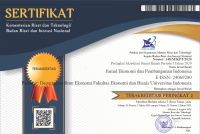Abstract
Asian’s financial crisis in 1997/1998 is a crisis that caused by exchange rate change which is contagious from one to another country. By having an active regional financial cooperation, this crisis can be prevented better. In the context of regional coordination, it is important to know the impact of exchange rate on inflation, whether it has a homogenous or heterogenous impact across ASEAN countries. By forming data panel of ASEAN-5, using broadmoney, trade openness and trading partner inflation rate as control variable with FGLS Estimator, it is known that the impact of exchange rate on Inflation in ASEAN-5 is heterogeneous.
Bahasa Abstract
Krisis keuangan di Asia tahun 1997/1998 yang terjadi merupakan krisis yang antara lain disebabkan oleh perubahan nilai tukar yang menjalar dari suatu negara ke negara lain (contagious). Krisis dapat dicegah lebih baik dengan kerja sama keuangan yang lebih aktif. Dalam konteks kerja sama, penting diketahui apakah dampak nilai tukar terhadap inflasi bersifat homogen atau heterogen (beragam) di ASEAN-5. Data panel yang dibentuk dengan pertumbuhan jumlah uang yang beredar, derajat keterbukaan perdagangan, dan tingkat inflasi di negara mitra dagang utama ASEAN-5 sebagai variabel kontrol dan menggunakan estimator FGLS, diketahui bahwa dampak nilai tukar terhadap inflasi di ASEAN-5 berdampak heterogen.
References
- Abimanyu, Y. (2004). Memahami kurs valuta asing. Lembaga Penerbit Fakultas Ekonomi Universitas Indonesia.
- Alba, J. D., & Papell, D. H. (1998). Exchange rate determination and inflation in Southeast Asian countries. Journal of Development Economics, 55(2), 421-437. doi: https://doi.org/10.1016/S0304-3878(98)00043-1.
- Barhoumi, K. (2006). Differences in long run exchange rate pass-through into import prices in developing countries: An empirical investigation. Economic Modelling, 23(6), 926-951. doi: https://doi.org/10.1016/j.econmod.2006.04.006.
- Bernhofen, D. M., & Xu, P. (2000). Exchange rates and market power: evidence from the petrochemical industry. Journal of International Economics, 52(2), 283-297. doi: https://doi.org/10.1016/S0022-1996(99)00047-1.
- Campa, J. M., & Goldberg, L. S. (2005). Exchange rate pass-through into import prices. Review of Economics and Statistics, 87(4), 679-690. doi: https: //doi.org/10.1162/003465305775098189.
- Campa, J. M., & M´ınguez, J. M. G. (2006). Differences in exchange rate pass-through in the euro area. European Economic Review, 50(1), 121-145. doi: https: //doi.org/10.1016/j.euroecorev.2004.12.002.
- Choudhri, E. U., & Hakura, D. S. (2006). Exchange rate pass-through to domestic prices: does the inflationary environment matter?. Journal of international Money and Finance, 25(4), 614-639. doi: https: //doi.org/10.1016/j.jimonfin.2005.11.009.
- Ciccarelli, M., & Mojon, B. (2010). Global inflation. The Review of Economics and Statistics, 92(3), 524-535. doi: https: //doi.org/10.1162/REST˙a˙00008.
- Cohen, B. J. (1993). Beyond EMU: the problem of sustainability. Economics & Politics, 5(2), 187-203. doi: https://doi.org/10.1111/j.1468-0343.1993.tb00074.x.
- Corden,W. M. (2002). Too sensational: on the choice of exchange rate regimes. MIT Press.
- Cortinhas, C. (2009). Exchange rate pass-through in ASEAN: Implications for the prospects of monetary integration in the region. The Singapore Economic Review, 54(04), 657-687. doi: https://doi.org/10.1142/S0217590809003458.
- de Bandt, O., & Mongelli, F. P. (2000). Convergence of fiscal policies in the euro area. European Central Bank Working Paper, 20. Diakses 2 Januari 2020 dari https://www.ecb. europa.eu/pub/pdf/scpwps/ecbwp020.pdf.
- Effendi, Y. (2013). Faktor penentu inflasi: studi kasus negaranegara ASEAN, 2001-2012 (Tesis, Pascasarjana Ilmu Ekonomi Fakultas Ekonomi dan Bisnis Universitas Indonesia).
- Falianty, T. A. (2006). Feasibility of forming currency union in ASEAN-5 countries. Research Laboratory of Economics, Department of Economics Faculty of Economics, Universitas Indonesia.
- Fleming, J. M. (1971). On exchange rate unification. The Economic Journal, 81(323), 467-488. doi: https://doi.org/2229844.
- Friedman, M. (1963). Inflation: Causes and consequences. Asia Publishing House.
- Goldberg, P. K. (1995). Product differentiation and oligopoly in international markets: The case of the US automobile industry. Econometrica: Journal of the Econometric Society, 63(4), 891-951. doi: https://doi.org/2171803.
- Hooper, P., & Mann, C. L. (1989). Exchange rate passthrough in the 1980s: the case of US imports of manufactures. Brookings Papers on Economic Activity, 1989(1), 297-337. doi: https://doi.org/2534500.
- Ingram, J. C. (1962). A proposal for financial integration in the Atlantic community. In Factors affecting the United States balance of payments : compilation of studies prepared for the Subcommittee on International Exchange and Payments of the Joint Economic Committee, Congress of the United States, 87th Congress, 2nd Session (pp. 195–207).
- Kenen, P. (1969). The theory of optimum currency areas: an eclectic view. In R. A. Mundell & A. K. Swoboda (Eds.), Monetary problems of the international economy (pp. 41-60). The University of Chicago Press, Chicago.
- Mankiw, N. G. (2009). Macroeconomics (7th Edition). Worth Publishers.
- McCarthy, J. (2000). Pass-through of exchange rates and import prices to domestic inflation in some industrialized economies. Staff Reports 111. Federal Reserve Bank of New York. Diakses 2 Januari 2020 dari https://www.newyorkfed. org/research/staff reports/sr111.html.
- McKinnon, R. I. (1963). Optimum currency areas. The American Economic Review, 53(4), 717-725.
- Mishkin, F. S. (2001). The transmission mechanism and the role of asset prices in monetary policy. NBER Working Paper 8617. National Bureau of Economic Research. doi: 10.3386/w8617.
- Mundell, R. A. (1961). A theory of optimum currency areas. The American Economic Review, 51(4), 657-665.
- Papell, D. H. (1994). Exchange rates and prices: An empirical analysis. International Economic Review, 35(2), 397-410. doi: https://doi.org/2527060.
- Simorangkir, I., & Suseno. (2004). Sistem dan kebijakan nilai tukar. Seri Kebanksentralan, 12. Pusat Pendidikan dan Studi Kebanksentralan (PPSK) Bank Indonesia.
- Stanoeva, G. (2001). The theory of optimum currency areas: an application to ten Central and Eastern European Countries. In International conference “Towards Regional Currency Areas”. Centre d’economie et de finances internationals, LARE-EFI, Universite Montesquieu, Bordeaux IV.
- Wimanda, R. E. (2009). Inflation and monetary policy rules: evidence from Indonesia (Doctoral dissertation, Loughborough University).
- Wimanda, R. E. (2011). Dampak depresiasi nilai tukar dan pertumbuhan uang beredar terhadap inflasi: aplikasi threshold model. Buletin Ekonomi Moneter dan Perbankan, 13(4), 409-432. doi: https://doi.org/10.21098/bemp.v13i4.266.
Recommended Citation
Rawang, Ashadi Asral and Ekananda, Mahjus
(2022)
"Analisis Fenomena Heterogenous Dampak Perubahan Nilai Tukar terhadap Inflasi di ASEAN-5,"
Jurnal Ekonomi dan Pembangunan Indonesia: Vol. 22:
No.
1, Article 3.
DOI: 10.21002/jepi.2022.03
Available at:
https://scholarhub.ui.ac.id/jepi/vol22/iss1/3








